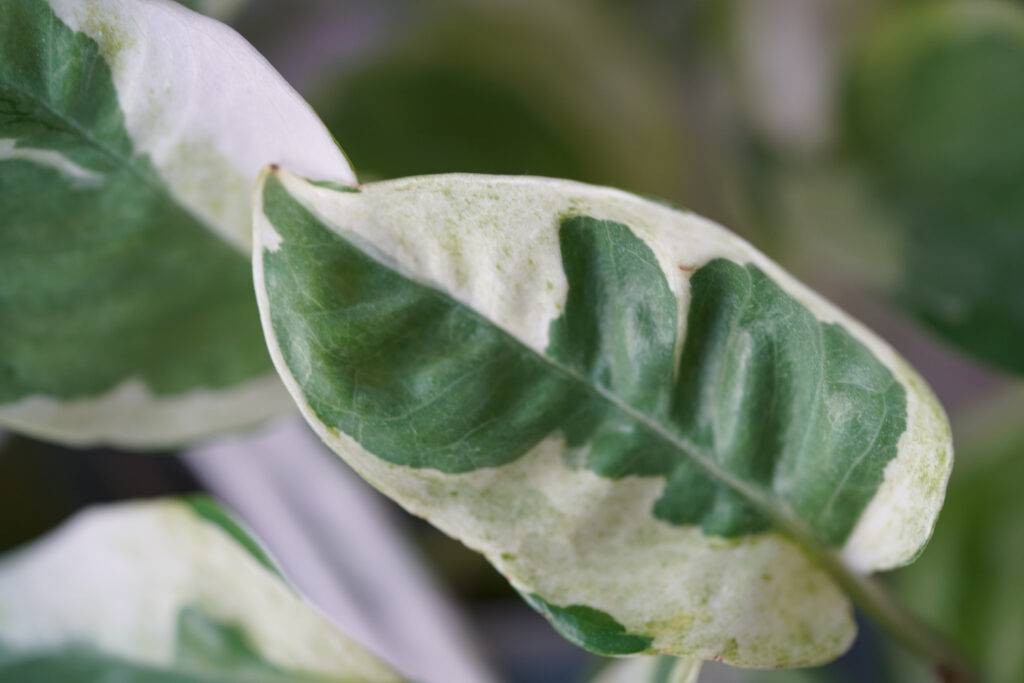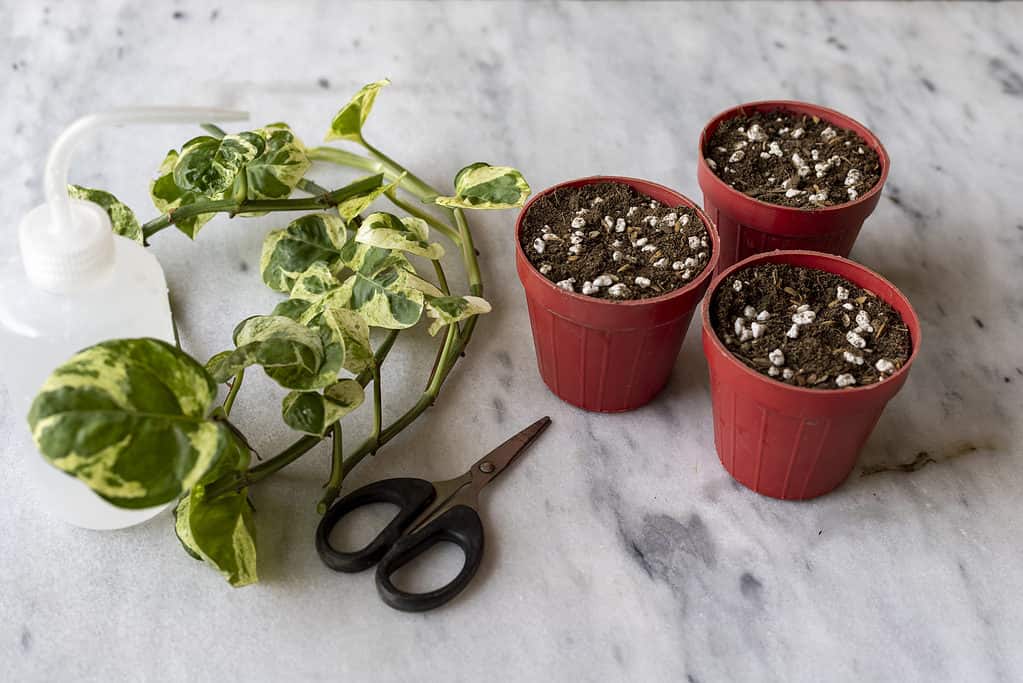With its distinctive mottled white and green variegation and tiny irregular leaves, the N’Joy pothos is a lovely Epipremnum aureum variation that stands out from the pothos throng. Although some plant enthusiasts might not like the name (it’s giving early 2000s SMS lingo, isn’t it?), this variety’s hardiness and eye-catching variegated leaves will make you forget about the long-lost memories of flip phones and allow you to reap all the benefits that this plant has to offer.
This more ornamental-looking, smaller, bushier cultivar offers various benefits for both terrariums and indoor spaces. In this guide, we’ll break down the benefits of this lovely pothos cultivar, as well as the care and growth requirements needed to keep this plant as healthy as possible.
What is the N’Joy Pothos?
The N’Joy pothos is an Epipremnum aureum cultivar from the Araceae family. This cultivar thrives in USDA hardiness zones 10 through 11 and can reach lengths of up to 10 feet. Although this variety is beautiful, it should be kept away from both children and pets since it is considered poisonous or toxic.
While the Epipremnum aureum species is native to the South Pacific Islands and nearby tropical areas, the N’Joy pothos variety was created in 2002 as a result of a naturally occurring branch mutation in a cultivar of marble queen pothos. Given that its leaves are so much smaller, have a wide range of shapes, and have a completely distinct variegation pattern, there is very little familial resemblance. We’re not complaining, though. This selective breeding process as yielded quite the beauty in the little N’Joy pothos.
The N’Joy pothos is the smallest pothos variety, with its distinctive green leaves and often white-edged variegation which really does resemble true ivy. Plant parents owe a debt of gratitude to Dr. Ashish Hansoti, who created the Manjula pothos and is responsible for many of the plant market’s magnificent indoor plant varieties today, for creating the N’Joy cultivar.

N’Joy pothos (pictured) are known for their chunky variegation that differs from common stripey and spotted variegation.
©iStock.com/Helena Bezold
How to Care for an N’Joy Pothos
In their natural habitat, pothos are understory plants that thrive in warm, humid conditions under the canopies of trees. They are therefore often well-suited to indoor cultivation where it is warm and there is a lot of indirect light. While the N’Joy pothos is a slow-growing variety of pothos, caring for them is comparable to caring for many of its cousins in the Epipremnum genus. They might need more light than some other varieties, such as the jade or golden pothos varieties, because their leaves are richly variegated and could disappear with too little sunlight. These tropical plants are typically thought of as durable, low-maintenance houseplants that are ideal for both seasoned and novice houseplant collectors.
The N’Joy pothos prefers a little bit of drying time in between waterings when grown inside. Water well, allowing the extra water to drain from the pot’s drainage holes after allowing the top two inches of soil to dry completely. Make sure the soil is not too wet and saturated because these pothos are prone to root rot if kept in overwatered soil.
The tropical floor of rainforests, where temperatures and humidity are high, is where pothos are used to flourishing. In spite of this, they are resilient plants that thrive in normal home temperatures and humidity levels. N’Joy pothos prefer humidity levels of 50% to 70% and ideal temperatures of over 65 degrees F. Try growing your plant in an area of your home that is naturally humid, such as the bathroom, if you are having trouble giving it the right amount of humidity. You can also plug in a small humidifier close by the plant.
The optimal light for these variegated plants is a lot of direct sunlight. The optimal location will get strong, indirect light for several hours. Avoid extended exposure to the sun since it might burn the delicate leaves of this pothos. Although it can start to lose its variegation and grow more lanky, the N’Joy pothos can also adapt to grow in low light.
Pothos, including the N’Joy pothos, need airy, well-draining organic soil that also holds some moisture. You can produce an excellent alternative at home using equal parts indoor potting soil, perlite, and orchid bark. Pothos appreciate being fertilized often during their active growing season to promote robust, healthy growth. For optimal results, apply a balanced liquid fertilizer once per month during the spring and summer. Throughout the fall and winter, don’t fertilize your pothos, as this can cause issues with the soil.
How to Propagate an N’Joy Pothos
Growing a new N’Joy pothos via propagation is easy and N’Joy-able. (Ha!) Like the majority of pothos plants, they can easily be propagated via stem cuttings with little more than clean scissors and some potting soil. Propagation is also an excellent technique to increase the size of an existing plant or produce new plants to give to friends and family.
To start, take a few stem cuttings from a healthy N’Joy pothos plant by using a pair of clean, sanitized scissors. For optimal results, each cutting should have three to four nodes along the stem. Each cutting should have the lowest one or two leaves removed, leaving the stem exposed.
The stem cuttings should be put in a container that has been prepared with fresh, dechlorinated, purified water. Make sure the stem is completely immersed and the remaining leaves are floating above the water. The cuttings’ container should be placed in an area with bright, indirect light, and the water should be changed once a week to keep it fresh. You should start to notice little white roots emerging from the stem’s nodes within a week or two.
Cuttings can be planted in soil once the roots are at least one inch long, preferably two inches. Plant the cuttings in the soil of a tiny pot that has been prepared with well-draining soil, and then give the container a good watering. To give the mother plant a fuller appearance, you might also want to replant the rooted cuttings in a shared container with it. For the first few weeks, keep the soil equally wet throughout and put the container in its original location to aid the roots’ transition from water to the soil.

N’Joy pothos (pictured) are quite easy to propagate with minimal tools.
©iStock.com/Bilal photos
Pests and Diseases to Watch Out For
N’Joy pothos are vulnerable to a few common pests and diseases, like the majority of houseplants. Be on the lookout for symptoms of common illnesses like root rot, which can be brought on by excessive moisture, as well as common pests like gnats, mites, mealybugs, and aphids that commonly affect houseplants. While pests and diseases can happen, this pothos variety is not particularly prone to pests as long as the plant is pest-free when you bring it home.
N’Joy pothos are typically trouble-free, easy to grow indoors, and require little maintenance. Yet, there are a few typical issues that you can run into, especially if you’re new to caring for pothos plants.
If you think that your N’Joy pothos is growing too slowly or not at all, a lack of light is typically to blame. A bright window should be a few feet away from these plants. If your plant is very far away from the nearest source of natural light and isn’t growing, it probably needs additional light. As opposed to other species like the golden pothos or marble queen pothos, these pothos plants are well-known for growing slowly, so don’t panic! Your N’Joy pothos is probably just taking its time.
One common issue is leaf yellowing. There are several potential reasons why the leaves on your N’Joy pothos are yellow. Overwatering, underwatering, a lack of light, or an excess of light are the most common reasons. You will need to examine your plant’s growth environment very closely in order to pinpoint exactly what might be causing the yellowing leaves. Between waterings, does the soil tend to stay wet? The problem is probably overwatering; make sure the soil dries out between waterings. Between waterings, is the earth growing dry, hard, and crispy? The culprit may then be underwatering. While direct light might result in yellow leaves from having too much sun exposure, make sure your plant is receiving bright, indirect light. The older leaves on your plant will likely turn yellow and drop in low-light regions so that energy can be saved for new development.
Brown leaves on an N’Joy pothos are typically easier to deal with than fading leaves. Most often, a lack of water or humidity is the problem if your plant starts to develop brown patches on its leaves or if the edges of its leaves start to turn dark. Be sure to water your plant as soon as the top two inches of soil are dry, and attempt to raise the humidity level surrounding the plant to stop it from browning any further.
Is There a Way to Boost the Growth Speed of My N’Joy Pothos?
N’Joy pothos are slow-growing plants, and there is no quick remedy or effective method to change this. But by giving your pothos the right care, including the right amount of light, water, temperature, humidity, and fertilizer, particularly during the growing season, you can ensure that your plant grows to its maximum potential.

The N’Joy pothos (pictured) is a slow grower that rarely grows longer than 10 feet long.
©iStock.com/Jamaludin Yusup
Can I Repot My N’Joy Pothos?
Every one to two years, or when the N’Joy pothos outgrows its pot and its roots poke out from the bottom, it should be repotted. Your plant needs to be repotted when its roots begin to emerge from the drainage holes in the pot or begin to circle the top or bottom of the container. However, you should postpone repotting your N’Joy pothos until the spring or summer because it is actively developing during this period and is less likely to experience shock during repotting than it would be in the fall or winter.
Make sure the new pot you select for your pothos is just one size larger than the one it was previously housed in. For example, you should relocate your pothos to a 12-inch pot if it is beginning to outgrow its 10-inch pot.
The N’Joy pothos is loved among plant enthusiasts and collectors for its absolutely stunning variegation and ivy-like appearance. As this variety stays relatively small, it’s the perfect pothos variety to keep in an office, dorm, or other small space. What’s not to love about the tiny N’Joy pothos?
Up Next:
- Pothos Roots: A Complete Guide
- Heartleaf Philodendron vs. Pothos: What is the Difference?
- Pothos vs. Devil’s Ivy: Is There A Difference?
The photo featured at the top of this post is © Christina Siow/Shutterstock.com
Thank you for reading! Have some feedback for us? Contact the AZ Animals editorial team.






